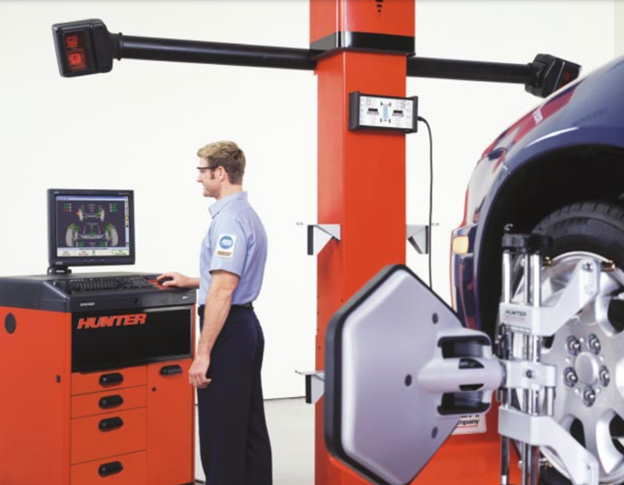
Wheel alignment has long been a cornerstone of automotive maintenance, essential for ensuring optimal vehicle performance, safety, fuel efficiency, and tire longevity. What once began as a purely mechanical, hands-on process has evolved into a discipline driven by precision engineering and cutting-edge technology. At the forefront of this evolution is Hunter Engineering, an American manufacturer renowned for its innovative approach to automotive service equipment. With more than 75 years of engineering excellence, Hunter Engineering has played a defining role in shaping the future of wheel alignment.
In this article, Hunter Engineering reviews the transformation of alignment technology—where it started, how far it’s come, and what today’s leading systems offer automotive professionals.
In the early decades of the automobile, alignment was as much an art as it was a science. Mechanics relied on rudimentary tools—such as string lines, plumb bobs, and bubble levels—to gauge alignment angles. These early methods involved manually inspecting suspension components and then making adjustments using hand tools and a careful eye.
The goal remained the same as it is today: align the wheels in accordance with manufacturer specifications for camber, caster, and toe. However, accuracy varied greatly depending on technician experience and environmental factors, and the process was time-intensive and prone to inconsistencies. Still, these early techniques laid the groundwork for more reliable, scalable solutions.
By the mid-20th century, as automotive complexity grew and customer expectations rose, alignment equipment took a leap forward with the introduction of optical alignment systems. These systems used mirrors and light beams to enhance measurement accuracy and reduce technician guesswork. Hunter was an early innovator in this space, producing equipment that delivered better results and streamlined shop workflows.
Optical systems marked the first significant technological advancement in alignment, offering greater precision than manual tools, though still requiring a level of technician expertise and setup time. This era also ushered in the standardization of alignment procedures and training, helping shops improve efficiency and service quality.
The 1980s and 1990s brought about another major shift: the integration of lasers. Laser alignment systems represented a transformative jump in both speed and accuracy. By projecting fixed laser beams across targets mounted on each wheel, these machines allowed technicians to obtain real-time readings with minimal calibration.
Laser-based systems were more resistant to external variables like lighting and floor-level inconsistencies, and they drastically reduced the time it took to complete a four-wheel alignment. As a result, alignment became a more profitable and routine service offering for repair shops and dealerships alike.
Hunter Engineering reviews how they helped lead the charge during this phase with the introduction of high-precision equipment that quickly gained recognition for reliability and repeatability. These systems allowed shops to offer alignments with greater confidence and consistency, boosting customer satisfaction and reducing the likelihood of returns.
The next evolution came with the dawn of the 21st century, as camera-based alignment systems began to replace laser tools. Hunter Engineering's HawkEye® Elite was a game-changer—using high-resolution cameras and advanced imaging technology to provide accurate, instant alignment readings.
Camera-based systems allow for the continuous measurement of all four wheels simultaneously. They eliminate much of the manual guesswork and offer real-time visual feedback to technicians through user-friendly software interfaces. For shops, this means faster alignment times, better customer communication, and a higher volume of vehicles serviced per day.
Hunter Engineering’s alignment systems also offer live ride height measurements, rolling compensation (no need to lift the vehicle for baseline calibration), and compatibility with modern suspension systems. These innovations dramatically reduce service time while enhancing precision—delivering alignment accuracy within fractions of a degree.
Today’s vehicles are more complex than ever, with many models featuring Advanced Driver Assistance Systems (ADAS) that rely on precise alignment and calibration to function correctly. Hunter has responded to this challenge by integrating tools like the ADASLink® Scan Tool into its alignment ecosystem.
ADASLink® is a full-diagnostic scan tool that bridges the gap between mechanical alignment and electronic calibration. It allows technicians to complete safety system calibrations—such as lane departure warning, adaptive cruise control, and automatic emergency braking—immediately after alignment, all within the same workflow. Combined with Hunter’s alignment and inspection equipment, this ensures that modern vehicles leave the shop not just properly aligned, but fully calibrated and road-ready.
Hunter Engineering reviews how they have also transformed how shops approach vehicle intake with systems like Quick Check Drive® and Quick Tread Edge®. These automated inspection tools use laser and camera technology to scan every vehicle as it enters the service lane—measuring alignment angles and tire tread depth in seconds.
This frictionless inspection process helps shops identify issues before the customer even steps out of the vehicle, increasing transparency and boosting alignment sales. For drivers, it means greater trust and a clearer understanding of vehicle needs. For shops, it’s a high-value tool for increasing revenue and efficiency.
Throughout every stage of alignment technology’s evolution, Hunter Engineering has remained committed to American manufacturing, world-class engineering, and industry-leading support. All of Hunter’s products are designed and built in the United States at its facilities in Mississippi and Missouri, with a robust field service and training network to support customers across the globe.
The company also maintains a forward-looking approach, investing heavily in research and development while maintaining a hands-on understanding of technician needs. With over 300 patented inventions and a team of dedicated engineers, Hunter continues to shape the future of wheel service equipment without chasing trends—only real, measurable improvements.
While the automotive industry continues to evolve—with electrification, autonomous features, and connected car ecosystems on the horizon—Hunter Engineering reviews that they remain focused on delivering proven, technician-friendly solutions that meet today’s challenges and tomorrow’s opportunities.
Wheel alignment may no longer require strings and bubble levels, but the goal remains unchanged: keeping vehicles safe, efficient, and performing at their best. Thanks to Hunter Engineering’s innovations, that mission is being achieved with greater speed, accuracy, and confidence than ever before.